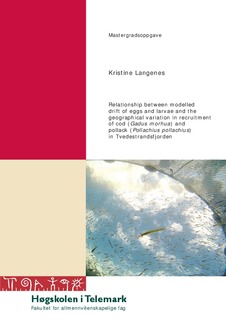| dc.contributor.author | Langenes, Kristine | |
| dc.coverage.spatial | Tvedestrandsfjorden | |
| dc.coverage.spatial | Tvedestrand | |
| dc.date.accessioned | 2016-01-18T09:41:36Z | |
| dc.date.accessioned | 2017-04-19T13:14:09Z | |
| dc.date.available | 2016-01-18T09:41:36Z | |
| dc.date.available | 2017-04-19T13:14:09Z | |
| dc.date.issued | 2016-01-18 | |
| dc.identifier.citation | Langenes, K. Relationship between modelled drift of eggs and larvae and the geographical variation in recruitment of cod (Gadus morhua) and pollack (Pollachius pollachius) in Tvedestrandsfjorden. Master thesis, Telemark University College, 2015 | |
| dc.identifier.uri | http://hdl.handle.net/11250/2438964 | |
| dc.description.abstract | Oceanographic current models are frequently used to predict particle drift in marine ecosystems. In our study, eggs and larvae of cod (Gadus morhua) and pollack (Pollachius pollachius) are used as particles in the model in order to evaluate if drift or other factors are decisive for spatial variation in recruitment in Tvedestrandsfjorden, a sheltered fjord in southern Norway. The study compares the modelled geographical drift distribution of particles with the measured geographical distribution of newly settled 0-group recruits. Eggs were collected in the spawning period (March – April 2014) and the highest egg-densities were found in the inner half of the fjord where the model predicted high retention of particles. Eggs were “released” in the drift model, based on our field data. The distribution after 30 days of drift suggested highest density in the innermost area of Tvedestrandsfjorden and the innermost area of a connected fjord arm, Eikelandsfjorden. During a beach seine survey in June 2014, 3 0-group cod and 39 0-group pollack individuals were caught. The density of juvenile pollack was highest in the innermost areas, the same area as the model predicted highest eggparticle densities after drift. Neither the modelled egg-density nor the factors area covered by the beach seine, flora type and coverage of flora were significantly affecting the amount of pollack when considered together in a generalized linear model. The results cannot conclude if the oceanographic model can explain the spatial variation in recruitment or not. Potential causes for the low recruitment of cod in Tvedestrandsfjorden in 2014 are discussed in the thesis. | |
| dc.language.iso | eng | |
| dc.publisher | Høgskolen i Telemark | |
| dc.subject | Gadus morhua | |
| dc.subject | Pollachius pollachius | |
| dc.subject | cod | |
| dc.subject | pollack | |
| dc.subject | geographical drift | |
| dc.title | Relationship between modelled drift of eggs and larvae and the geographical variation in recruitment of cod (Gadus morhua) and pollack (Pollachius pollachius) in Tvedestrandsfjorden | |
| dc.type | Master thesis | |
| dc.description.version | Published version | |
| dc.rights.holder | © Copyright The Author. All rights reserved | |
| dc.subject.nsi | 480 | |
| dc.subject.nsi | 497 | |
